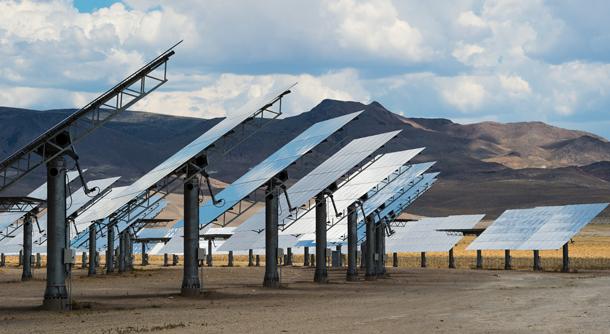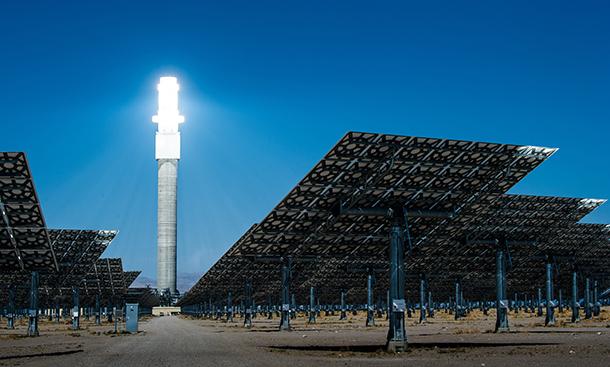Solar energy gets an endurance boost from salt
SolarReserve’s Crescent Dunes plant in Nevada trains light from mirrors on a core tower to heat molten salt that can be used to run a turbine to produce electricity immediately or stored to make electricity hours later.
A project in the Nevada desert offers a compelling solution to a problem that has long bedeviled the solar power industry: How to store energy from the sun for use at times when the sun doesn’t shine.
Crescent Dunes, run by a company called SolarReserves, is a 110-megawatt concentrated solar power (CSP) plant that uses molten salt to store heat captured from sunlight. The system works by using mirrors to shine blindingly bright light at a 650-foot tower.
“That's where the work is being done,” says reporter Rob Dieterich, who recently wrote an article about this project for Inside Climate News. “Basically, the reflected sunlight from the mirrors, from the heliostats, is heating molten salt that's circulating up and down through that tower.”
The salt used is not ordinary table salt, Dietrich explains. Table salt is sodium chloride, whereas the salt used at Crescent Dunes is a 60-40 blend of sodium nitrate and potassium nitrate.
The light heats the salt to just over 1,000 degrees Fahrenheit. Once the salt is heated, it is stored in an insulated tank, where it can sit for days and barely lose any temperature. Then the molten salt is run through a heat exchanger to create steam, which is then used to run a standard power turbine.
“You could basically run the turbine all the way through the night if you want to,” Dietrich says. “It's all just a calculation of how many mirrors you have, how much salt you can heat up during the day and then what size turbine you run on it.”

Crescent Dunes, which right now is the only commercial-scale plant of its type in operation, can store enough molten salt to run for 10 hours after the sun goes down, Dietrich says, and they could have designed it to run longer. “They could have had slightly more mirrors, which would allow them to heat more salt during the day and they could have gone to 12 or 14 hours,” Dietrich explains. “It's just a calculation of what the grid needs, which is honestly a very important thing.”
Current wind and solar photovoltaic facilities can make power only under the right conditions. Power operators don’t get to choose, Dietrich explains. But “with a plant like this, you can set it up so that it runs for however many hours you think you need to meet your peak demand after the sun goes down.”
While battery technology is much improved from what it was even a couple years ago and companies like Tesla are using it to extend solar energy's usefulness in the nighttime hours, on a large, power grid scale, thermal storage is much more efficient than battery storage, Dietrich says. “Until you get some kind of a chemistry breakthrough, something that’s substantially more efficient, you're not really going to get to the level where you've got storage on the scale and efficiency of the sort of plant that we're talking about.”
What’s more, the energy produced from facilities like Crescent Dunes may soon be priced competitively with other types of energy, Dietrich says. Crescent Dunes’ current contract, created in 2009, is 13.5 cents per kilowatt-hour. SolarReserves now says they can produce power for less than half that price in the next plant they build. A plant in Australia expected to begin construction this year will sell power for about six cents per kilowatt-hour.
This is an important threshold, Dietrich says. “Six cents per kilowatt hour is the threshold that the Department of Energy and others observing this industry think is the price you need to get to if you're going to be competitive with fossil fuels.”
Still, it’s unclear whether this technology can be deployed on a larger scale, Dietrich says.
“The technology they're using goes back to a demonstration project that was operated 20 years ago,” he notes. “Even with all that time having passed, we've got just the one operating plant and it hasn't been without its glitches. They feel like it's all worked out and that the plant’s running well now, but you've got to build two, three or four more before anybody is going to really be sure that the plants can be built to budget, built on time, that they run the way everybody predicts and that the economics that are being promised when they sign contracts right now can be seen in real life.”
This article is based on an interview that aired on PRI’s Living on Earth with Steve Curwood.
